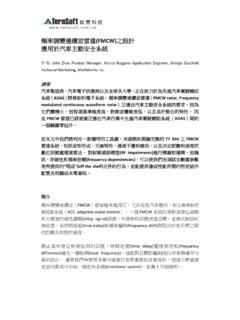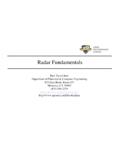Transcription of Using a complex-baseband architecture in FMCW radar systems
1 Using a complex-baseband architecture in fmcw radar systemsKarthik RamasubramanianRadar systems ManagerTexas InstrumentsUsing a complex-baseband architecture in fmcw radar systems 2 May 2017 AbstractThis white paper explains the advantages of a complex-baseband architecture in frequency - modulated continuous wave (FMCW) radar systems . Typical radar front-end implementations use a real mixer with a real baseband and analog-to digital converter (ADC) chain. However, there are performance advantages that can be leveraged with the use of a quadrature mixer and complex-baseband architecture in the context of fmcw radar .
2 This architecture has been implemented in the 76 81-GHz fully integrated complementary metal-oxide semiconductor (CMOS) millimeter wave (mmWave) sensors from Texas first part of this white paper describes the complex-baseband architecture in the context of fmcw radar and the advantages of this architecture . The second part explains how complex baseband does not increase the memory requirements or computational burden on the digital signal processing (DSP) , radar implementations used discrete components (power amplifiers [PAs], low-noise amplifiers [LNAs], voltage-controlled oscillators [VCOs], analog-to-digital converters [ADCs]), but more integrated solutions are now becoming available.
3 A complementary metal-oxide semiconductor (CMOS)-based radar that integrates all radio- frequency (RF) and analog functionality as well as digital signal processing (DSP) capability into a single chip represents the ultimate radar system-on-chip solution. Such a highly integrated device significantly simplifies radar sensor implementations, enables a compact form factor for the sensor, and makes the solution cost effective. Texas Instruments (TI) offers a family of highly integrated 76 81-GHz radar devices for the rapidly growing automotive and industrial radar white paper focuses on a particular aspect of Texas Instruments 76 81-GHz radar devices: the use of a quadrature mixer and complex-baseband architecture instead of the traditional real mixer and real baseband radar conceptLet s review the operating principle behind FMCW radars.
4 In fmcw radar solutions, the transmitted signal is a linear frequency - modulated continuous wave (L-FMCW) chirp sequence, whose frequency vs. time characteristic follows the sawtooth pattern shown in Figure 1 on the following page. The frequency fT(t) and phase FT(t) of the linear FMCW transmit chirp are expressed as linear and quadratic functions of time, as shown in Figure a typical fmcw radar implementation (Figure 2 on the following page), the local oscillator (LO) module generates a linear frequency - modulated continuous wave signal, cos(FT(t)), which is amplified by the PA and transmitted from the object(s)
5 Present in the region of interest illuminated by the radar reflect the transmitted Using a complex-baseband architecture in fmcw radar systems 3 May 2017signal. The receive antenna receives the reflected signal and the LNA amplifies it. This received signal mixes with the LO signal to produce the beat- frequency (intermediate- frequency [IF]) output, which the ADC digitizes and the DSP subsequently 3 depicts the nature of the received FMCW signal, which comprises different delayed and attenuated copies of the transmit signal corresponding to various objects.
6 You can see that the beat- frequency signal corresponding to each object is a tone (ignoring the edge effects at the start and end of the chirp), whose frequency , fb, is proportional to the distance of the object from the radar , R. Therefore, the process of detecting objects (targets) and their respective distances from the radar involves taking a fast Fourier transform (FFT) of the beat- frequency signal and identifying peaks that stand out from the noise 1 t Tchirp fIF cRtd2=22)()(tTBtfttTBftfchirpcTchirpcT +=+=)(tfTFigure 1.
7 FMCW sawtooth signal 2 LO Gen. IF X ADC DSP PA LNA ))(cos(tT Figure 2. High-level block diagram of an FMCW time Tchirp fb cRtd2=Tvalid chirp Transmit chirp signal fb f Beat frequency spectrum Noise Objects at different distances Received signal(s) reflected from various objects RF frequency Figure 3 Figure 3. Received fmcw radar signal and beat- frequency a complex-baseband architecture in fmcw radar systems 4 May 2017In reality, there are many details beyond this very simplified explanation of fmcw radar detection, particularly when considering moving objects.
8 For moving objects, the beat- frequency signal also has a Doppler component that depends on the relative velocity between the radar and the target. You can estimate the Doppler component and hence the relative velocity by performing a second FFT across chirps and looking at the phase shift of the beat signal from one chirp to the next. To summarize, the detection process involves performing a first-dimension FFT of the received samples corresponding to each chirp and then a second-dimension FFT of this output across chirps.
9 The result of the two-dimensional FFT procedure is an image of the target(s) in the range-velocity grid. The detection process occurs on the 2-D FFT output and involves detecting peaks amid the noise floor or surrounding most implementations, there is also an angle-estimation process based on beamforming with multiple antennas, although I won t get into those details in this white radar implementation Using real basebandMost radar implementations today use a real mixer and real (I-only) baseband and ADC chain. This type of implementation is partly motivated by the cost advantages obtained by not having to double the number of ADCs and variable gain amplifiers (VGAs) in discrete-solution-based radar 4 illustrates the instantaneous spectrum of the transmit (LO), receive (RX) and beat- frequency (IF) signals.
10 Figure 4a shows the LO signal cos(FT(t)) spectrum representing the instantaneous frequency of the ramping LO. The RX signal spectrum in Figure 4b contains delayed and LO frequency ramping a) LO (TX) signal b) RX signal LO frequency ramping c) IF signal 0 77 GHz 0 Inband Image band f f f cos( T(t)) RX signal mixed with cos( T(t)) (real mixer) Figure 4 Figure 4. A real mixer and real baseband suffers from image-band noise foldback. (a) Instantaneous spectrum of LO (TX) signal showing ramping frequency , (b) RX signal after reflection from various objects, (c) IF signal after real a complex-baseband architecture in fmcw radar systems 5 May 2017attenuated versions of the LO signal representing different targets.














